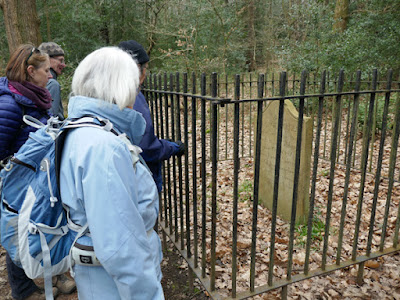For the Sheffield U3A Geology Group field trip in November 2022, I had proposed a walk from Whinfell Quarry Garden to Ecclesall Woods to look at the Rough Rock, the industrial archaeology and Neolithic rock art – based on sections of the Sheffield Round Walk that I had visited more than once since spring 2017.
 |
| In Whinfell Quarry Garden |
As recorded in many Language of Stone Blog posts, which describe the Rough Rock in Sheffield, Huddersfield and Leeds – in rock outcrops, historic buildings, paving and urban landscaping – I have got to know this geological formation quite well, but there is always something new to learn
Moving from Whinfell Quarry Garden to the old quarry next to the Limb Brook Trail, via Fenney Lane, we had a look at the differential weathering of the alternating layers of siltstone and sandstone, which has resulted in the undercutting of the sandstone beds.
For the next leg of the field trip, we had a quick look at the Whirlow Wheel and Limb Brook to examine the outcrops of Rough Rock in the streambed and banks and to look at the shape and size of the boulders that had been transported down the brook.
15 months before, I had been to Ecclesall Woods with another group member Linda, who had been working on an archaeology project that was attempting to determine the geological provenance of the large boulder into which had been cut the Neolithic rock art. Of the two most likely rock formations in the vicinity, the Crawshaw Sandstone and the Rough Rock, I thought the flaggy nature of the Rough Rock around Sheffield would preclude it, but we decided to go and look at this formation at Whirlow and Limb Brook in January 2022.
We continued through Ecclesall Woods to look at the few remains of Ryecroft Mill, before we made our way down to the Grade II Listed footbridge (c.1800) over Limb Brook, which is bedded on large slabs of sandstone to prevent erosion of the bridge supports.
The next stop was the ochreous spring that flows from old shallow coal workings, where the orange colour is the result of the microbial degradation of the mineral pyrite, which frequently occurs in coal seams and the associated strata that are laid down in anaerobic conditions.
Making our way up the dip slope of the escarpment that overlooks Ryecroft Glen, we stopped briefly to look at one of the numerous Q-pits that are found in Ecclesall Woods, before continuing past the bird sanctuary and making our way down to the J.G. Graves Woodland Discovery Centre, where we had lunch.
After lunch, we crossed into Wood 2, passing the old ganister quarry that has been filled with water to make a pond before continuing to the Charcoal Burner's Memorial and then to another old ganister quarry in Wood 1, where we searched around the overgrown waste tips to see if we could find any interesting specimens.
Our last stop on the day was to look at the Neolithic rock art, which comprises a large flattened boulder of gritstone, which has very coarse angular and sub-rounded grains of quartz that vary from 5 mm to 8 mm in diameter. Into this has been cut various cup and ring patterns, but nobody in the group was able to say much about it.
Our exploration of the geology ended in the eastern part of Wood 1, where several streams flow and the ground is littered with boulders of sandstone that have been brought down from the high ground to the west and which are probably Crawshaw Sandstone.












No comments:
Post a Comment